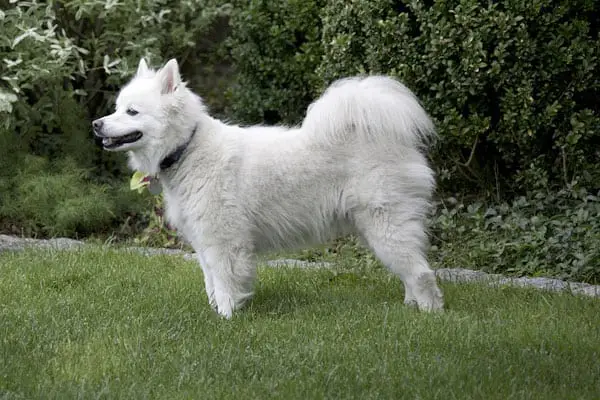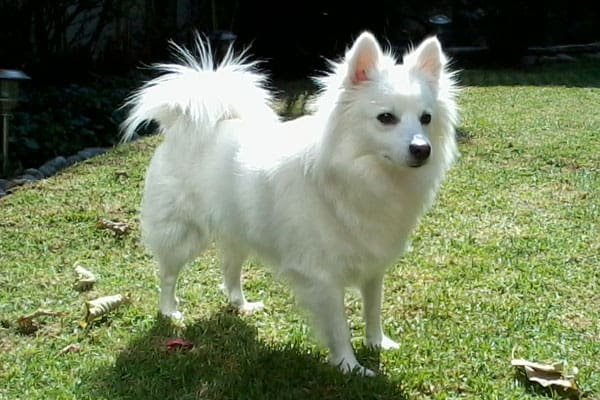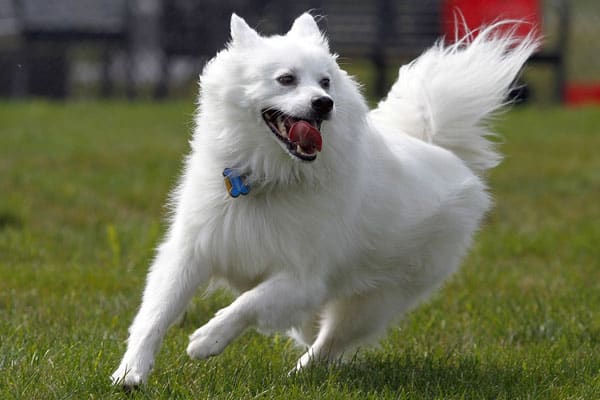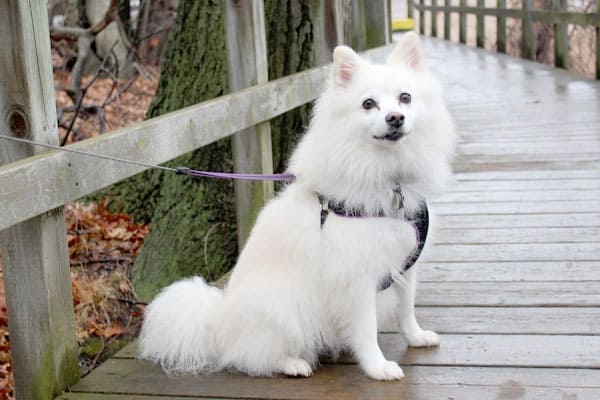American Eskimo Dog Running Partner: Yes, Your Esky Can Run With You

American Eskimo dogs are a fascinating breed. These dogs are becoming more popular because they look like tiny polar wolves with their pointy ears and thick fur coats.
But your dog may need some training and socialization to learn how to be a good running partner to you.
Eskies, as this dog breed is often nicknamed, have some temperament traits and instinctive drives that can cause problems if they do not get early and ongoing socialization and training around other people and animals.
In this article, we will explain how to make sure you and your dog have the best possible experience jogging and running together.
American Eskimo Dog Running Partner
The American Eskimo dog can make a good running partner provided you wait until your puppy has completely grown up.
It is also important to run at times during the day when it is cooler so your dog won’t overheat.
And just like when you start your own fitness program, you want to build up to running longer distances with your dog. Start with short sprints and work your way up to longer runs so your dog won’t get injured.
Watch Two American Eskimo Dogs Running and Playing
In this owner-made YouTube video, you can watch two American Eskimo dogs doing tricks, playing, and running. They are very quick and speedy!
However, it is also important to remember that these dogs are quite small, especially toys and miniature Eskies. They have short legs and a very heavy double-layer fur coat, so fatigue and overheating is something you always want to keep an eye out for.
Important Considerations Before Running With an American Eskimo Puppy
According to the American Kennel Club (AKC) breed profile overview, the American Eskimo dog is bred in three different sizes: standard, miniature, and toy.
While there can be some overlap, you can use this information to identify what size your dog might grow up to be based on the size of the parent dogs (if you met them).
Standard American Eskimo dog
A standard Esky typically weighs between 25 and 35 pounds and stands 15 to 19 inches tall.
Miniature American Eskimo dog
A miniature Esky typically weighs between 10 and 20 pounds and stands 12 to 15 inches tall.
Toy American Eskimo dog
A toy Esky typically weighs between six and 10 pounds and stands 9 to 12 inches tall.
This is very important to know if you want to take your Esky running with you, because the smaller the dog, the faster they will finish growing up.
The faster your dog finishes growing, the faster the growth plates at the end of the long leg bones will harden and close. This means your dog can run and jump and play and exercise without any risk of joint, cartilage, bone, or tissue damage.
Toy and miniature Eskies will grow up faster than standard size Eskies. But all three size dogs are likely to finish growing in about 12 months.
The only way to know for sure that it is safe to take your Esky with you on jogs is to have your canine veterinarian do X-rays of your dog. Your veterinarian can examine the X-rays and confirm whether the growth plates have hardened and closed.
Until this happens, you must restrict the intensity of your dog’s exercise for their safety and health.
Just to be safe, Ready to Go Veterinary Rehab suggests waiting until your dog is between 14 and 16 months old before attempting any strenuous exercise, including running or canine sports.
However, if your dog’s veterinarian clears you earlier, then you can start running together as soon as the growth plates have closed permanently.
Be Sure to Socialize and Train Your American Eskimo Dog Before Jogging
Together
As the American Eskimo Dogs Organization of Vancouver explains, American Eskimo dogs by their very nature are protective of their people.
These dogs need a lot of socialization and training to learn that not every strange person or animal is a potential threat or potential prey.
An Esky that is not socialized or trained may try to bark or lunge at people who come too close to you and may try to chase every squirrel, bird, or car they see.
This can put your dog in harm’s way and also put you into some sticky situations with your neighbors and their pets.
You also need to make sure your Esky is leash-trained before you go out in public to go running together.
American Eskimo dogs are spitz-type dogs with a working dog and sled dog history and lineage. They are too petite to serve in these types of jobs, but their ancestors definitely did and they haven’t lost the instinct to run and run.
You can’t let an American Eskimo dog off-leash safely without the threat that your dog will run away and will not return to you when you call. This is just part of this breed’s personality.
They don’t want to disobey you but they have very strong instincts to run and chase that can’t always be overridden just by hearing a command.
A spitz-type dog like the Esky won’t easily understand the purpose of a leash and will have to get used to it.
As this YouTube video showcases, you also want to make extra sure that you have a completely dog-proof, escape-proof yard before you bring your American Eskimo dog home. These dogs are completely capable of jumping a five or six-foot fence!
So you will need to install extra precautions such as a fence topper to keep your dog from escaping and running away.
Here again, your Esky doesn’t necessarily want to escape and run away from you. They just have very strong, deeply embedded instincts to jump and run and may get themselves into trouble they can’t get out of if your yard isn’t escape-proof.
What to Expect When You Start Running With Your American Eskimo Dog
As this American Eskimo dog owner Reddit thread highlights, many owners find it eye-opening to run with their Esky for the first time.
These dogs are lightning fast!
One owner suggests using a harness with a front clip to help control your dog more easily during runs without putting extra pressure on their neck.
And because the American Eskimo dog comes from a working and sled dog background, they are typically eager for every bit of exercise and activity they can get. So your dog will rely on you to pace them as you build up endurance together.
Your dog will also need your help to learn how to run on a lead and not pull or jump.
As VetStreet points out, it is also important not to over-feed your dog because this can put more pressure on the joints and cause injury.
You want to ramp up your jogging together slowly for both your sakes. Just because Eskies are literally made to run doesn’t mean they can’t get injured if they do too much too soon.
Special Running Considerations With Miniature and Toy American Eskimo Dogs
If you have a miniature or toy size American Eskimo dog, you may not be able to run with your dog in the way you could with a standard Esky.
This is because these dogs are just too little to have the endurance for longer runs. A quick jog down the street and back in cool weather might be doable. But think twice before taking such a tiny dog for a longer run.
For toy-size Eskies, in particular, they are so tiny that they could experience blood sugar depletion if they exercise too vigorously for too long a period of time without eating or drinking.
But even miniature Eskies should be closely monitored for over-exertion that could lead to muscle or tendon sprains or tears over time.
The best approach is to talk with your canine veterinarian about the best types of exercise you and your dog can enjoy together and how long it is safe to run before your dog will need a rest.
Avoid Running With Your American Eskimo Dog During the Heat of the Day
The American Eskimo dog has a classic spitz-type canine coat.
It is a double-layer coat. The outer layer is formed from guard hairs that are coarser and water-resistant and designed to be protective.
The inner layer is soft and downy and serves as natural insulation against the cold and wet.
Suffice it to say that these dogs are wearing their heavy winter jackets year-round!
Imagine how hot you would feel if you went out running in the summer in the middle of the day wearing your down ski parka. You would probably overheat quickly and have to stop and sit down.
The same danger is present for your dog if you try to go running or hiking or walking together when it is very hot outside.
And if you are tempted to shave your dog’s coat in the summer to protect your Esky from overheating, this will destroy the coat’s protective properties forever. So you never want to do this.
Rather, simply schedule outside playtime and jogging when it is cooler outside in the early morning or after dusk.
How Much Daily Exercise Does an Adult American Eskimo Dog Need?
Miniature and toy-size American Eskimo dogs typically do well with mostly indoor play and activity. They can enjoy a walk or two outdoors each day when it is cooler as well.
But as VCA Animal Hospitals explains, the larger standard Eskies really need an outside walk or jog each day.
Overall you should aim for about 45 minutes of high-quality exercise daily to keep these dogs happy and avoid destructive behavior.
If jogging for 45 minutes doesn’t sound doable or fun to you, you can certainly break up your dog’s activity needs into shorter segments. This can actually be better for your dog too so they have something to look forward to throughout the day.
Training sessions, learning and performing tricks, canine agility, and athletics, interactive playtime, swimming, hiking, walking, and jogging are all great physical exercises you and your Esky can enjoy together.
You can also bring your Esky to local dog parks to socialize and play with other dogs, which can be great to burn off steam if you can’t go jogging with your dog for some reason.
Health Concerns to Watch for When Jogging With Your Esky
As the Animal Health Center of New Hampshire explains, the American Eskimo dog breed is known to be prone to certain heritable (genetic) joint problems.
The most common of these are hip dysplasia and patellar luxation.
Hip dysplasia happens when the hip joint fails to develop properly so the two bones grind against each other, causing pain and lameness.
Patellar luxation, or trick kneecap, is a laxity or looseness in the knee joint that causes the knee to drop out of socket or dislocate. This is also very painful and can cause lameness.
Both issues can be treatable with medication and physical therapy when they are minor, but when they are severe, surgery is usually the only option.
If you notice your dog picking up one leg and limping or skipping and hopping and then kicking a leg out to the side, schedule an appointment with your canine veterinarian to have X-rays done.
And don’t do any further jogging together until you know what is causing the issues so you don’t inadvertently make the joint problems worse.
Standard American Eskimo dogs often love jogging and running longer distances with their humans. Toy and miniature Eskies also typically like going for short runs up and down the block in cool weather.
By knowing what you need to do to train, socialize, and prepare your dog for a great running experience, you can both enjoy many years of running together as a duo.


